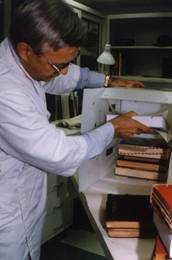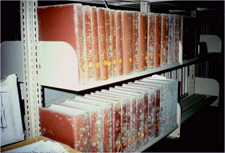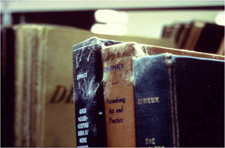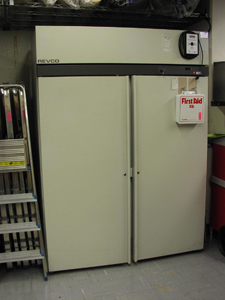 Emergency Preparedness and Response
Emergency Preparedness and Response
Sample Emergency Plan: Stabilization and Salvage of Wet General Collection Materials
Stabilization and Salvage of Wet General Collection Materials
Wet general collection materials must be removed from storage areas as soon as [Insert your institution's Facilities Office] has declared the areas safe to work in. Removing wet material reduces the amount of moisture in the space and minimizes the risk of mold growth.
- Mold. DO NOT HANDLE MATERIALS THAT HAVE ANY SIGNS OF ACTIVE MOLD GROWTH. If active (moist, slimy, fuzzy) mold growth is evident, contact:
[Insert your institution's Division of Occupational Health and Safety's telephone/contact information]
If mold has been detected and you know that you are susceptible to potential mold-related health problems, do not work in the emergency area.- Active mold growth typically occurs in areas where relative humidity cannot be controlled within 48 hours, but can occur sooner depending on ambient conditions. Relative humidity over 70% for an extended period of time is likely to trigger growth. All active mold needs to be evaluated because molds that are potentially toxic cannot be identified by color. Both genus and species need to be known to correctly identify mold.
- Inactive mold is dry and powdery. Guidance is available from the Heritage Preservation and/or Northeast Document Conservation Center (NEDCC). Do not run fans in an area where dry, powdery mold is present.
- Removal of materials from affected areas.
- Work in teams to remove materials carefully from shelves. If use of a ladder is necessary, be sure ladder is secure on dry matting and shoes are dry before stepping on ladder.
- Use gloves to protect hands. Both nitrile and latex gloves are available in the emergency carts and other emergency supply areas.
- Respirators should be available that filter up to 0.02 micron particles. A dust mask is not a respirator. If you are at risk for any potential health problems associated with mold, do not work in the emergency area.
- Handle wet materials with care. Lift each soaked item firmly and carefully. For information on collection salvage, please see books and bound materials section and the printable instructions for salvage procedures.
- Place items upright on book truck and secure with hand or bookend to prevent further distortion. Do not attempt to force a bookend under wet volumes.
- Move items to the area that the preservation professional in charge of the recovery operation has identified for processing.
- Discharge materials from online catalog.
- Charge out materials in the online catalog so that patron and staff will know they are not available for use while being dried or replaced.
- If items have not been entered into the circulation system, write call numbers down on a note pad. For journals, also record volume and/or issue numbers and year/month of publication. Work in teams: one person reads the number; one person writes the number down. This helps reduce errors.
- Salvage options.
- Salvage actions depend on the type of material and the severity and extent of the emergency. Large quantities of wet general collection print materials will be frozen. Depending on the severity of the damage and the number of staff available to assist, a small number of wet items can be air-dried. Other materials may require special processing.
- Air drying slightly wet General Collection books and journals.
- Air drying works best for small numbers of items that are damp or only slightly wet. Otherwise, move wet items into a freezer. For information on collection salvage, please see books and bound materials section and the printable instructions for salvage procedures. Aim small rotating fans toward them to quicken the drying process. (Do not use squirrel cage or floor fans for this purpose!) Interleave books or issues of journals that are somewhat wet with paper towels.
- Air drying materials made with coated paper.
- For information on collection salvage, please see books and bound materials section and the printable instructions for salvage procedures.
- Support for oversized bound volumes
- For information on collection salvage, please see printable instructions for salvage procedures.
- Freezing
- For information on collection salvage, please see books and bound materials section and the printable instructions for salvage procedures.
[Insert location of your institution's onsite freezer if there is one. Have a list of local freezer companies available for Emergency Response Chief to contact.]
- Packing wet books for freezing.
- Assemble corrugated high-density polypropylene boxes available in [Insert location at your institution].

- Place container on its side and insert wet books (charged out to [Insert location]) spine down, interleaving with deli-wrap.
- If there are not enough wet items to fill the container, use crumpled plain paper to fill the gap between the wet volumes and the side. Be sure to firmly support the end volume. Use a piece of corrugated board, found [Insert location at your institution] as an additional support if necessary to prevent further distortion.

Last Reviewed: August 22, 2018




